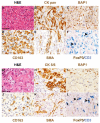Mesothelioma Malignancy and the Microenvironment: Molecular Mechanisms
- PMID: 34830817
- PMCID: PMC8616064
- DOI: 10.3390/cancers13225664
Mesothelioma Malignancy and the Microenvironment: Molecular Mechanisms
Abstract
Several studies have reported that cellular and soluble components of the tumor microenvironment (TME) play a key role in cancer-initiation and progression. Considering the relevance and the complexity of TME in cancer biology, recent research has focused on the investigation of the TME content, in terms of players and informational exchange. Understanding the crosstalk between tumor and non-tumor cells is crucial to design more beneficial anti-cancer therapeutic strategies. Malignant pleural mesothelioma (MPM) is a complex and heterogenous tumor mainly caused by asbestos exposure with few treatment options and low life expectancy after standard therapy. MPM leukocyte infiltration is rich in macrophages. Given the failure of macrophages to eliminate asbestos fibers, these immune cells accumulate in pleural cavity leading to the establishment of a unique inflammatory environment and to the malignant transformation of mesothelial cells. In this inflammatory landscape, stromal and immune cells play a driven role to support tumor development and progression via a bidirectional communication with tumor cells. Characterization of the MPM microenvironment (MPM-ME) may be useful to understand the complexity of mesothelioma biology, such as to identify new molecular druggable targets, with the aim to improve the outcome of the disease. In this review, we summarize the known evidence about the MPM-ME network, including its prognostic and therapeutic relevance.
Keywords: cancer stem cells; inflammation; macrophages; mesothelioma; tumor microenvironment.
Conflict of interest statement
The authors declare no conflict of interest.
Figures


References
-
- FDA: U.S. Food and Drug Administration FDA Approves Drug Combination For Treating Mesothelioma. [(accessed on 26 September 2021)]; Press release. Available online: https://www.fda.gov/news-events/press-announcements/fda-approves-drug-co....
-
- Mangone L., Storchi C., Bisceglia I., Romanelli A. Malignant Mesothelioma in the Italian Region Emilia-Romagna: Incidence and Asbestos exposure update to 2020. Ann. Res. Oncol. 2021;1:199–208. doi: 10.48286/aro.2021.20. - DOI
Publication types
LinkOut - more resources
Full Text Sources

